mobile View, to the German Version tap the flag


- 1025–1474 County of Schleswig
- 1474–1864 Duchy of Schleswig, bond with the Duchy of Holstein
- 1867 to the Prussian Province of Schleswig-Holstein
- 1946 to the Country of Schleswig-Holstein
• Flags
• Meaning/Origin of the Flag
• Coat of Arms
• Meaning/Origin of the Coat of Arms
• Map
• Numbers and Facts
• History
• Origin of the Country's Name
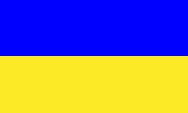
Colours of Schleswig



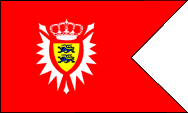
16th–18th cent.,
Flag of the Dukes of Holstein-Gottorf, Dukes of Schleswig and Holstein
Source, by: Flags of the World




18th cent. – 19th cent.,
Sea flag of Schleswig and Holstein,
Source, by: Flags of the World,
Flaggen aller Seefahrenden Nationen



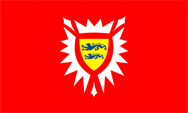
1848–1851,
Sea flag of Schleswig and Holstein,
Source, by: Flags of the World



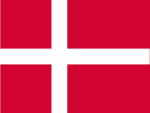
1773–1864,
Schleswig, Holstein and Lauenburg belong to Denmark,
Source: Corel Draw 4





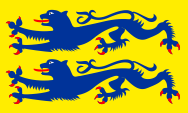
unofficial flag of the Danish minority in Schleswig and Holstein,
Source: Wikipedia (D)





The colors of Schleswig are blue and yellow. They have their roots in the coat of arms of Schleswig, which shows two blue lions on gold. This heraldry is of Danish origin, because the coat of arms of Denmark showed originally three blue leopards/lions on gold. The in the 12th century created Danish Duchy of Schleswig was often awarded to Danish princes and potential Danish heirs of the throne, so that only two leopards/lions appear in the coat of arms of Schleswig.
Schleswig was bond since 1474 with Holstein, but not until 1830 was introduced an unofficial, sometimes even illegal common flag, in the colors blue, white and red. It quickly got the status of a symbol of freedom and represented the German independence movement against Denmark. Its colors are a combination of the colors of the countries Schleswig (blue and yellow) and Holstein (white and red), but there was waived the yellow out of the colors of Schleswig, because it was strived for a tri-color flag, following the example of France.
The German Revolution of 1848 gave the independence movement of the Germans in Schleswig and Holstein an enormous boost. The black, red and gold German flag and the flag of Schleswig and Holstein in the colors blue, white and red, got none international recognition, particularly at sea, and at ses there was used a flag from 1848, which was nearly similar to the flag of the dukes of Gottorf, but it had no swallowtail, and oftenly there was no crown on the flag.
The success of the German revolution became gradually reversed after 1848, the black-red-golden German flag disappeared and even the blue-white-red flag sank in illegality under the ongoing Danish rule.
The desire for freedom of the Germans in Schleswig and Holstein was goaded again after breaking the promises of Denmark for an own constitution in 1863, and the German Confederation intervened again after 1848. During this second German-Danish war of 1864 were Schleswig, Holstein (including Lauenburg), but also Jutland occupied by Prussian and Austrian troops, and after the withdrawal of Austria in 1865 Schleswig-Holstein became in 1867 a Prussian province. The blue-white-red flag remained in illegality, and was never recognized by Prussia. It was officially adoped not until 1949 on the occasion of the joining of Schleswig-Holstein to the FRG, and it became officially confirmed not until 18th of January in 1957 by law.
A separate flag for Schleswig is probably not used. Widespread is a flag with the image of the coat of arms of Schleswig, two blue lions on yellow, but almost exclusively within the members of the Danish minority in Schleswig.
Source, by: Flags of the World,
World Statesmen,
Volker Preuß

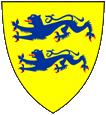
1386-1866
Coat of arms of Schleswig,
Source: Wikipedia (D)

The coat of arms of Schleswig shows two blue lions on gold. This heraldry is of Danish origin, because the coat of arms of Denmark showed originally three blue leopards/lions on gold. The in the 12th century created Danish Duchy of Schleswig was often awarded to Danish princes and potential Danish heirs of the throne, so that only two leopards/lions appear in the coat of arms of Schleswig. Schleswig was indeed connected with Holstein from 1474, but it remained as a separate duchy, in fact until the formation of the Prussian province of Schleswig-Holstein in 1866. As long the coat of arms of Holstein remained. For Schleswig-Holstein was created a common coat of arms.
Source, by: Wikipedia (D),
Flags of the World,
www.heraldique.org

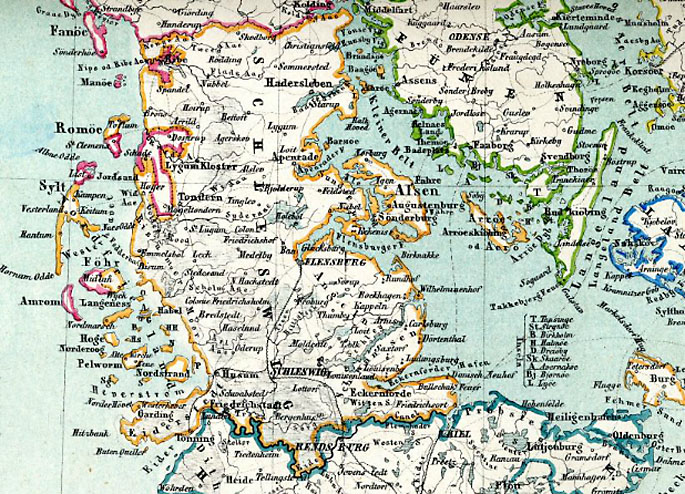
Source: Brommes Illustrirter Hand-Atlas 1862
This historical map of 1862 shows the Duchy of Schleswig within a orange-coloured outline.
In the south borders the Duchy of Holstein within a blue outline, in the north Denmark in red and green.

Area: 3.550 square miles (1855)
Inhabitants: 363.000 (1855)
Density of Population: 102 inh./sq.mi. (1855)
Residenz: Gottorf
Sprachen: German, Low German, Danish
Currency to 1868: Danish Taler
Currency from 1868: 1 Taler = 30 Silbergroschen = 360 Pfg.
Currency 1875–1924: 1 Mark = 100 Pfennig
Currency 1924–1947: 1 Reichsmark (RM) = 100 Reichspfennig (Rpf.)
Source: Herders Conversations-Lexikon,
Wikipedia (D),
Der Michel

5th century · in today's Schleswig settles the Germanic tribe of the Angeln
6th/7th century · the Angeln emigrate to Britain, immigration of Danes
ca. 925 · German conquest by King Heinrich I.
ca. 930 · establishing of the Margraviate of Schleswig
ca. 940 · German conquest of the whole Jutland-Peninsula by King Otto I.
948 · founding of the Diocese of Schleswig
1027 · the Margraviate of Schleswig is left to the Danes, the Eider River becomes determined as the northern border of the German Empire
1115 · Schleswig becomes a Danish Duchy
1152 · Duke Valdemar I. of Schleswig acknowledges the German suzerainty by fief
1157 · Valdemar I. becomes King of Denmark, Denmark and Schleswig are in personal union
1386 · Count Gerhard of Holstein (from the House of Schauenburg) receives the Duchy of Schleswig by the King of Denmark as a fiefdom
1459 · death of Count Adolf VIII., extinction of the male line of the House of Schauenburg
1460 · the corporatives of Schleswig and Holstein elect the nephew of Adolf VIII., King Christian I. of Denmark (from the House of Oldenburg), as Duke of Schleswig and Count of Holstein, with the pledge of the king to let the countries of Schleswig and Holstein territorially unchanged as well as granting of independence of both countries and granting of special privileges and rights
1474 · Schleswig and Holstein are connected under the Danish crown by contract, Holstein is a part of the Holy Roman Empire of German Nation until 1806, Schleswig is not
1544 · the line of the Dukes of Holstein (the Oldenburg-Danish royal house) shares into a Danish main line (with the secondary lines Holstein-Sonderburg-Augustenburg and Holstein-Gluecksburg) and the side line of Holstein-Gottorf, which retains the control of the country, it is named by Gottorf Castle near the City of Schleswig, in the afteryears nascence of a strong opposite between the Danish kings and the Gottorf dukes
1544-1773 · country subdivisions by the divisions of the Holstein lines, into Royal Danish possessions, ducal possessions and common possessions
1700–1721 · Nordic War: Denmark, Saxony, Poland, Russia, Prussia, Hannover against Sweden and Gottorf, Sweden and Gottorf lose, the house of Holstein-Gottorf flees to Russia, Russia becomes an east european leading might
1721 · King Frederick IV. of Denmark confiscates Schleswig as a forfeited Danish fiefdom, the Duchy of Schleswig comes back to the Danish kings, the to this date to Holstein-Gottorp belonging island of Heligoland comes to the Danish Duchy of Schleswig
1773 · contractual arrangement between Denmark and Russia: Schleswig and Holstein remain undivided, the older house of Holstein-Gottorf (now Czars of Russia) cedes Holstein in favor of the kings of Denmark, Denmark cedes Oldenburg and Delmenhorst to the younger line of the house of Holstein-Gottorf, Schleswig becomes (with Holstein and Lauenburg) a member of the Danish-Norwegian state, the Danish king is - as Duke of Holstein - a German prince, and thus a part of the Holy Roman Empire of German Nation, beginning of a policy of danization towards the German population
1806 · Napoleon forces the creation of the Rhine Confederation, an alliance of sixteen southern and southwestern German states under French protectorate, which declare themselves sovereign and resign from the Holy Roman Empire of German Nation, hereupon Emperor Franz II. lays down the crown of the Holy Roman Empire of German Nation, the empire ends, Schleswig, Holstein and Lauenburg become annexed to Denmark
1807 · the island of Helgoland is occupied by British troops
1814 · Peace of Kiel, Helgoland is part of Great Britain
1815 · Congress of Vienna, reconstruction of Europe after the era of Napoleon, the ownership and the administrative partitions in the former German Empire become restored, but not the sovereignty of the ecclesiastical countries, their possessions become transferred to old or new principalities, the 39 remaining German states become organized in a loose association, the German Confederation
1815 · Holstein is a member of the German Confederation
1822 · the corporatives of Schleswig and Holstein ask the German Confederation for help to safeguard their interests against the Danish krone, according to the state constitution of 1448, however, without success
1834 · Denmark grants a consultative instituitinal assambly of the corporatives, but the succession for the Duchy of Schleswig remains unregulated - causing unrests, Denmark forces a danization the country
1848 · King Christian VIII. of Denmark terminates the absolute monarchy and dies on 20th of January, uprisings in Schleswig and Holstein
March 1848 · Bourgeois revolution in the German Confederation, establishing of a provisional government for the Duchies of Schleswig and Holstein, forming of a Schleswig-Holstein army, an attack on Schleswig becomes blocked by Danish troops, attack of Prussia against Denmark, occupation of the Jutland Peninsula by Prussian troops, but they retreat promptly from Jutland and remain in Schleswig and Holstein
22nd of October in 1848 · constituent Assembly of a Schleswig-Holstein parliament
March 1849 · attack of Danish troops
1850 · Prussia withdraws from Schleswig and Holstein
1851 · troops of the German Confederation (troops of Prussia and Austria) occupy Holstein
25th of July in 1851 · Battle of Idstedt, the Schleswig-Holstein army becomes defeated by Danish troops and completely destroyed
1852 · Treaty of London: Denmark makes commitments to the German Confederation, regulation of the throne succession in Schleswig and Holstein in accordance with Danish ideals, in turn granting of special rights for both countries, Austria and Prussia become warranty mights the duchies of Schleswig and Holstein become handed over by the German Confederation to Denmark, Holstein and Lauenburg remain in the German Confederation
1853 · Schleswig gets a constitution
1854 · Holstein gets a constitution
1863 · new Danish constitution (Eider-Danish Constitution), break of the promises, Denmark tries to annex Schleswig and Holstein in contradiction to the London Treaty, Austria and Prussia mobilize their forces
1864 · Second German-Danish War, Schleswig, Holstein and Jutland be occupied by German troops
1864 · peace of Vienna: Denmark cedes the Duchies of Schleswig, Holstein and Lauenburg to Austria and Prussia (German Confederation)
1865 · Austria retires
1866–1867 · Prussian-Austrian War, or German War or Fratricidal War, defeat of Austria (German Confederation) and its allies against Prussia and its allies, Austria hands over his rights on Schleswig and Holstein to the king of Prussia, Prussia acquires Schleswig-Holstein, Hanover, Hesse-Kassel and Nassau, smashing of the German Confederation and Prussia forces the establishment of the North German Confederation
1870–1871 · German-French War, German victory within five months, on 18th of January in 1871 will be proclaimed the German Empire at Versailles
1st of July in 1890 · Heligoland-Zanzibar Treaty, Helgoland comes from Great Britain to Prussia and is thus a part of the German Empire
1914–1918 · First World War, the German Empire with the Central Powers is defeated to the troops of Entende
1919 · Diktate of Versailles, in the outskirts of the German Empire, in which minorities live, become esablished in 1920 voting areas in which should make referenda about the political affiliation, Schleswig becomes divided into three zones
1920 · plebiscite, zone 1 (North Schleswig) - 74,2% for Denmark, zone 2 (Middle Schleswig) - 19,8% for Denmark, zone 3 (South Schleswig) - no plebiscite, North Schleswig comes to Denmark
1939–1945 · Second World War, at the time of surrender (7th to 9th of May in 1945), Schleswig-Holstein is to the largest parts still in the hand of the German war-might. The government of the German Empire seats still until the 23rd of May in 1945 in Flensburg. After the demobilization of the war-might squads gets the Province of Schleswig-Holstein occupied by the British, and becomes transformed to the Land of Schleswig-Holstein on 23rd of August in 1946.
1949 · Schleswig-Holstein becomes a federal country of the FRG
Source:
Wikipedia (D),
Historisches Deutschland,
Atlas zur Geschichte,
Herders Conversations-Lexikon

The name of the country "Schleswig" has its roots in the town with the same name, the capital of the country. It actually consists of two parts, "Schlei" and "wig". Schlei is the name of the river on which the town is located, and the word "wig" comes from the Old High German word "wih", meaning "place" or "housing". Schleswig is thus the "Place on the Schlei".
Source: Handbuch der geographischen Namen







![]()






















